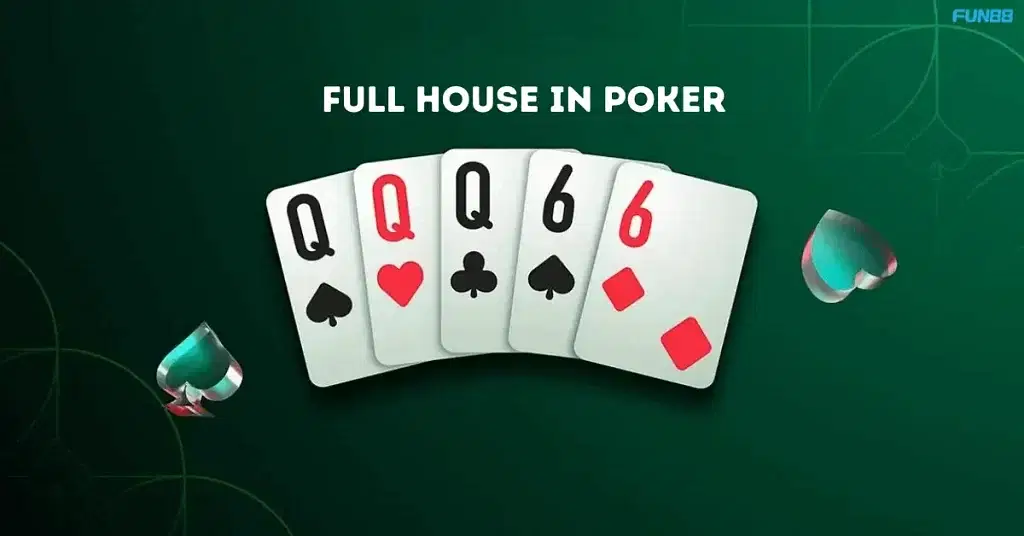Poker is not merely a game of chance but a fascinating game of strategy, deft skills, and understanding hand rankings. Amidst the flurry of combinations lies the mighty Full House —a hand that excites seasoned players and novices alike.
Picture this: a poker game enthusiast feverishly pushes chips into the pot, showcasing the revered Full House. It’s no ordinary hand.
Today, we shall unravel the mysteries behind the Full House in Poker. From grasping its strength to playing it with finesse, this comprehensive guide has got you covered on all fronts. Let’s begin this journey.
What is a Full House in Poker?
In Poker, a Full House is a hand comprising three cards of one rank and two cards of a different rank. Simply put, envision it as the combination of a three-of-a-kind and a pair. This hand has the power to turn the tables in your favour.
For instance, a Full House could show as three Kings and two 10s, displayed as K♣ K♦ K♥ 10♠ 10♦. This blend of cards stands as one of the strongest hands you’ll encounter, effortlessly outmuscling hands like a Flush, Straight, or Three-of-a-Kind.
Full House Poker Ranking
Poker hands are ranked by how likely they are to occur. The Full House is fourth in the standard poker hand rankings hierarchy. Here’s a quick snapshot of the top-tier rankings:
● Royal Flush: The unassailable hand—a straight from 10 to Ace, all of the same suit.
● Straight Flush: Five consecutive cards, all suit-matched.
● Four-of-a-Kind: Four cards that share the same rank.
● Full House: Three cards of one rank are paired with two cards of another.
This ranking ensures that while a Full House beats several formidable hands, it kneels before the likes of a Four-of-a-Kind, Straight Flush, or Royal Flush.
How is a Full House Formed?
The formation of a Full House can diverge based on the poker variant you’re diving into. In variants like Texas Hold’em and Omaha, players fashion Full Houses using private hole cards and shared community cards. You can play Poker online on Fun88 to get through these facilities:
Example in Texas Hold’em:
Imagine you’re holding A♠ A♣ as your hole cards.
The community cards are A♦ 5♠ 5♥ 9♦ 3♣.
Here, you craft a Full House of Aces full of 5s. The stronger your three-of-a-kind component, the tougher your opponent’s task to defeat it.
Example in Omaha:
With K♠ K♦ 10♠ 5♣ in hand and community cards K♥ 5♦ 5♠ Q♠ 3♥, you build a Full House: Kings full of 5s—a robust hand to wield.
Related Read: 10 Expert Tips to Become a Poker Expert: Level Up Your Skills
Full House Hand Rankings Explained
A Full House’s might is undeniable, yet not all Full Houses are created equal. The hierarchy of one Full House over another stems first from the three-of-a-kind; the pair ranks second.
Example 1: Full House vs. Full House
Imagine Player 1 wields Aces full of Kings (A♠ A♦ A♣ K♥ K♠).
While Player 2 carries Kings full of Aces (K♠ K♦ K♣ A♥ A♠).
Player 1 emerges victorious, courtesy of higher-ranked three Aces against three Kings. Should the three-of-a-kind tie, the decision falls to the pair.
Example 2: Identical Full Houses
Both players hold Queens full of Jacks (Q♠ Q♥ Q♦ J♠ J♣).
The match records a tie in this encounter, necessitating a split pot.
How to Play a Full House in Poker?
Mastering how to wield a Full House in Poker can significantly influence your poker triumphs. While formidable, a Full House is attainable. Here, we list strategies to enhance your winnings when holding a Full House—and minimise losses when not.
Maximising Value with a Full House
Leverage the potency of a Full House to rake in chips from inferior hands like straights, flushes, and trips. Here’s how:
● Slow Play in Position: Slow playing can lure bluffs or lead opponents to overvalue weaker hands if you hold a dominant position (like the button) and the board is gentle (with no straights or flushes).
● Aggressive Play in Multi-Way Pots: When multiple foes are still in the round, take your Full House into battle with aggression. Multi-way pots boost the odds that someone else holds a strong hand, and you don’t wish to give anyone freebies to catch up.
Recognising When Your Full House is Beaten
Undoubtedly strong, Full Houses are not invincible. Keep an eagle eye on the board texture. A Straight Flush or Four-of-a-Kind possibility warrants caution.
● Board-Pairing Situations: If the table pairs to expose potential quads (four-of-a-kind), heed your opponents’ betting cues. An example: Your Aces full of 8s feel threatened if an 8 pairs on the board, opening possibilities for someone wielding four 8s.
● Avoiding Over-Commitment: Even with a formidable hand like a Full House, don’t hesitate to retreat to caution if danger looms. This proves especially true in large pots where adversaries could wield a mightier Full House or quads.
Full House in Different Poker Variants
Across poker variants, the grandeur and ranking of Full Houses remain consistent, though their formation can vary slightly with rule differences.
Here’s how the Full House moulds into various poker landscapes:
Texas Hold’em
As the reigning champion among poker variants, Texas Hold’em regularly showers players with Full Houses, especially in crowded games. Your Full House might indeed derive from community cards. If the board pairs, multiple players might land Full Houses, with the greatest three-of-a-kind taking the reward.
Omaha
Given four-hole cards and the necessity to use precisely two, Omaha offers ample opportunity for crafting Full Houses in Poker. However, it remains critical to decipher board dynamics and likely opponent dealings with various possible hands.
Seven-Card Stud
In Seven-Card Stud, with players unveiling hands from seven cards—three face-down and four face-up—constructing a Full House is slightly more challenging. Yet when achieved, it stands as a towering hand.
When to Fold a Full House?
Though rare, occasions arise where folding a Full House may become pivotal. Sensing when to lay down your Full House demands honed skill and an intimate read on fellow players.
Examples:
● Paired Board with Heavy Action: Picture holding Queens full of Jacks while your opponent kicks up aggressive action on a board of A-A-J-J-3. Chances increase; they might flaunt four of a kind, eclipsing your Full House.
● Straight Flush Possibility: When four cards for a straight flush beckon on the board, reconsider your Full House’s stability, especially amid multiple players determined to snag the pot.
Also Read: Best Online Poker Tournaments Around the World and India
Conclusion
In Poker, a Full House ranks favourably among the power players just below a Four-of-a-Kind. Its merits demand understanding rank placement, playing with both daring and caution, and adapting fluid tactics for diverse poker variants.
Be it Texas Hold’em, Omaha, or Seven-Card Stud, savviness with the Full House in Poker can swiftly transform you into a formidable table presence. Embrace the art of patience, soak in the lessons from each hand, and with practice, let the Full House be your steadfast companion in the poker arena.
Create an account on Fun88 and play Poker online to experience the best of live casino gaming. May your ventures be brimming with wisdom and, of course, victorious.
Star it if you find it helpful.

